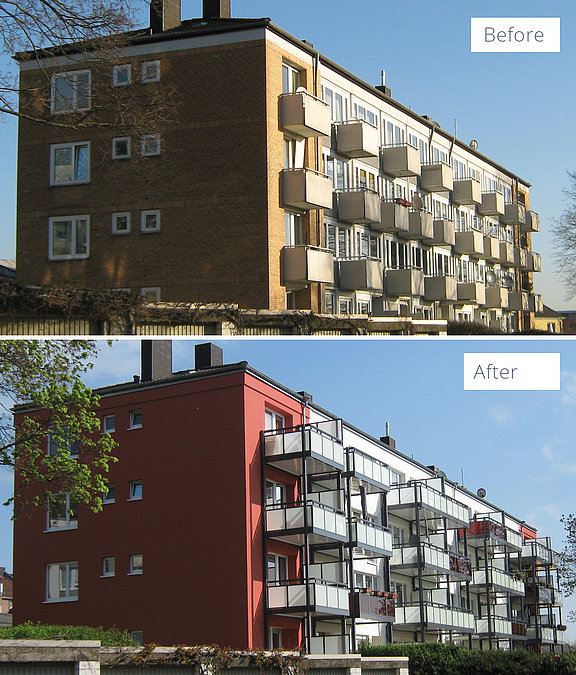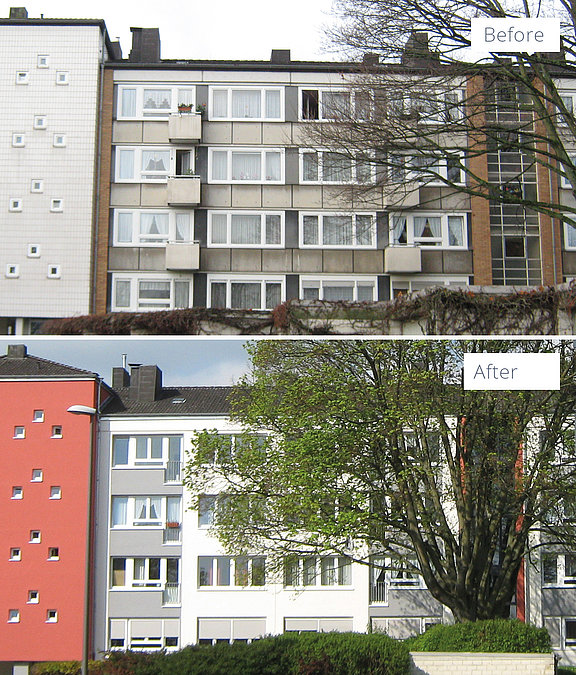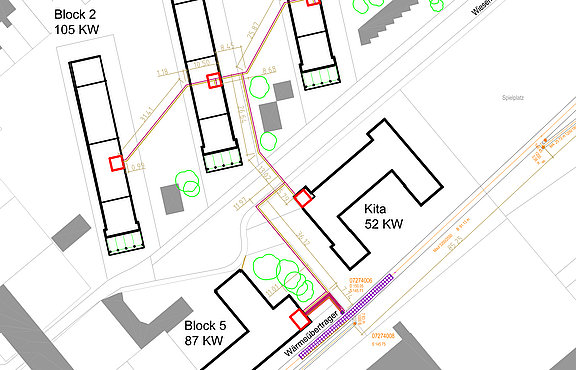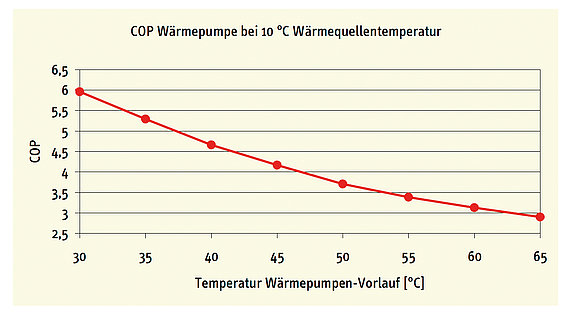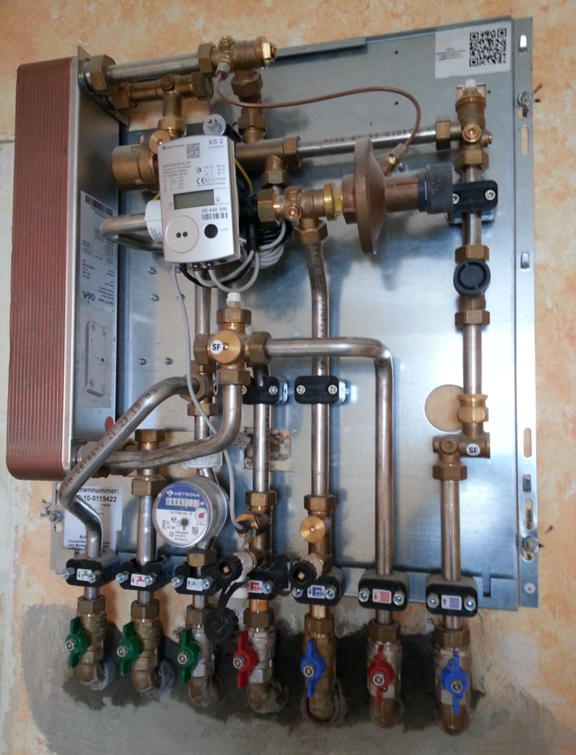![[Translate to Englisch:] [Translate to Englisch:]](/fileadmin/_processed_/e/3/csm_EN_Vorher-Nachher_02_9f6b5b8eab.jpg)
LINEAR customer ECO.S Energieconsulting delivers energetic renovation concept
In cooperation, the City of Aachen and the housing company gewoge AG renovated 377 inner-city block apartments between 2013 and 2018 within the framework of the EU-GUGLE funding project. The aim of the project was to reduce Co2 consumption in the neighbourhood by insulating the enveloping surface (reducing the energy requirement), choosing the energy source and reducing consumption through tenant advice. The measures enabled energy savings of 50 to 54 percent to be achieved. When implementing the MEP concept, the parties involved relied on the software solutions from LINEAR.
The energetic renovation measures essentially include the insulation of the enveloping surfaces, the replacement of balconies to avoid thermal bridges, the installation of new windows and the installation of modern building heating and technology such as ventilation systems, some with heat recovery and LED general lighting. A special challenge: 67 per cent of the buildings refurbished in the project are listed buildings, which significantly limits the possibilities of external wall insulation. The renovations were carried out in order to maintain low rents and to keep them as economical as possible. The energetic refurbishment was accompanied by further structural modernisation measures, for example, of the bathrooms, as well as the creation of partly new apartment layouts and an overall visual upgrading of the buildings and the individual residential units. Advising tenants and broad information work on energy saving and the correct use of the new technology is also an accompanying activity. The aim was to improve the quality of life and living in the entire neighbourhood. The modernisations were carried out within the framework of the EU-GUGLE project (EUropean cities serving as Green Urban Gate towards Leadership in sustainable Energy), which is funded by the EU Commission. Further information can also be found at www.eu-gugle.eu, www.aachen.de/eu-gugle.
EU-GUGLE enabled an innovative, effective and sustainable contribution to the achievement of the climate goals in the city of Aachen through the cooperation of the city, gewoge AG and the municipal utilities. With the experience gained from the project, the urban building stock will be upgraded further in the future. Thanks to the joint commitment, inexpensive living space could be maintained despite high-quality refurbishment.
Of the 377 apartments in total, 271 were connected to a heat supply system based in part (148 apartments) or exclusively (123 apartments) on waste water heat from the sewerage system.
Fundamentals of Building Services Design
The main part of the heat energy for heating and hot water comes from two heat pumps, which use the nearby sewer as a heat source and supply the buildings via a local heating network (Fig. 1). The ECO.S engineering office, which was also responsible for the renovation of the heating, plumbing and ventilation systems in the inhabitated state, was responsible for the concept and design.
The premise for the technical building equipment is therefore a technical concept for heating and hot water preparation, which enables an energetically and economically efficient heat pump operation.
Heating
Two factors are decisive for achieving the goal of low heating network temperatures:
A panel heating circuit (underfloor heating) is not possible due to the renovation in inhabited condition. Due to the energetic renovation of the building envelope, the realization of low design temperatures of, for example, a maximum of 50 °C is also possible with radiators without any problems.
Hot water generation
There are two basic options for hot water generation: centralised or decentralised.
For central hot water generation - whether with hot water tank or fresh water station - a hot water temperature of 60 °C must be ensured for hygienic reasons. This requires permanent temperatures of about 65 °C from the heat generator. This temperature can be reached with heat pumps. However, this is not efficient in terms of achieving a high annual performance factor: Despite a favourable heat source with temperatures above 12 °C throughout the year, the annual coefficient of performance can hardly exceed 3.0 if 65 °C has to be delivered permanently (Fig. 2).
Decentralised water heating solves this dilemma. The key question here is whether the hot water is generated electrically or via the heating network. The operating costs for the tenant are highest with electric hot water preparation. Also, despite the fact that 40 % of the electricity generated is renewable, the environmental balance is not optimal. Decentralised hot water preparation can also be carried out via the heating network, which is then operated all year round. Here the high unit costs for the dwelling stations are often a deterrent. In addition, there are manufacturers who demand heating network temperatures of 55 °C and more, which is not far away from the 65 °C of the central hot water supply. However, both handicaps can be overcome: Specialised manufacturers supply dwelling stations that reliably deliver hot water temperatures of 40 to 42 °C even with 48 to 50 °C heating flow. In practice, there are no complaints from tenants with these temperatures.
The question of costs is also not critical on closer inspection. Tenants have the greatest possible advantage when it comes to operating costs: The energy comes from the heating system and is much cheaper than electricity. In addition, the amount of energy is 30 to 50 % lower, as three quarters of the circulation losses are eliminated. Finally, the costs for billing the hot water meter are eliminated.
The investment costs require a careful comparison in order to arrive at reliable and realistic statements. The costs for dwelling stations are offset by investments for central hot water preparation:
- Hot water network and circulation network incl. fittings
- Hot water tank / fresh water station
- Circulation pump
- Fittings for hydraulic balancing of the heating network (this also takes place in the dwelling station)
- Additional heat pump costs for 65 °C instead of 55 °C maximum flow temperature
- Investments / rents for hot water meters and heat cost allocators
The dwelling station makes it possible to measure the tenant's total energy consumption for heating and hot water preparation via a single heat meter. The water consumption for cold and hot water is also only recorded by a single cold water meter (Fig. 3).
In addition, there are no costs for regular sampling of the hot water network. From a hygienic point of view, it is always advantageous to dispense with the storage of heated potable water.
In Wiesental the following figures were obtained as examples for one of the four blocks of flats:
Controlled Domestic Ventilation
The last component in the energy concept is ventilation: Modern dense construction requires minimum mechanical ventilation for moisture protection. A pure exhaust air system was implemented in Wiesental the supply air is ensured via window rebate ventilators.
The exhaust air from all approx. 30 housing units of a block is brought together in the attic. The heat energy contained therein is recovered centrally via an exhaust air heat pump and fed into the heating network. Since the exhaust air is permanently in operation, i.e. 8,760 hours a year, and has temperatures of over 20 °C, a very cost-effective heat pump operation is possible here, which covers part of the heat load - in this project approx. 15 % of the output.
This concept can be implemented in both refurbishment and new construction with the lowest investment costs, but the heat recovery rate is still high and, last but not least, the electricity costs for the ventilator are just as low as the maintenance costs. After all, the technology in the attic and central heating plant is accessible at all times, access to the rented apartments is not required.
Technical implementation
The CAD and calculation implementation was carried out by the ECO.S engineering office with software solutions from LINEAR. ECO.S has been using these software solutions successfully for more than 10 years and appreciates in particular the detailing and depth in the technical calculations. Especially important are the calculation possibilities of the LINEAR software in the area of the used dwelling stations on the heating as well as on the potable water side. By the possibility of the selection of different simultaneity approaches the systems can be simulated and optimized. Beyond that also the dimensioning of the buffer memory is possible over the LINEAR software, indispensable for the correct interpretation of a heating system with dwelling stations. Extensive data sets of specialized manufacturers round off the service portfolio and allow the generation of correct mass compilations directly from the calculations.
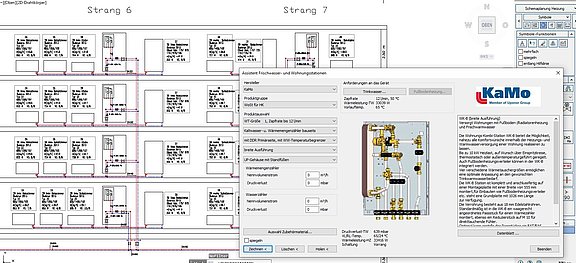
Renovation of the Building Envelope
In order to reduce the energy requirements of the 123 apartments in the Wiesental project, it was necessary to upgrade the energy efficiency of the building envelope. The façades of the buildings from the 1960s with integrated balcony slabs and a wide variety of surfaces (tiles, clinker, plaster, curtain walling) showed age-related damage. The existing balconies were sawn off and replaced by balcony towers to minimize the thermal bridges. The floor space of the balconies was adapted to today's needs, i.e. balconies at the living rooms were enlarged, very small exits at the kitchens were removed. Altogether the living space could be enlarged.
All windows including existing roller shutters as well as the single-glazed staircase windows were renewed. These windows were equipped on the basis of a ventilation concept with window rebate ventilators as supply air openings. The originally existing flat roofs were already fitted with an uninsulated saddle roof in the 1980s. For this reason, insulation of the top floor ceiling was realized, the remaining height is sufficient for use as a dry storage. The room can also be used for laying the exhaust air ducts and installing the central exhaust air fan. The room height of the basement was sufficient for the installation of a basement ceiling insulation. A technical room ("sub-centre") was constructed for each apartment block, and tenant basements were relocated accordingly. The package of measures was supplemented by a renewal of the house and apartment entrance doors, and the electrical house connections were also renewed. With this package of measures and the change in heating system, not only the objectives of the European project but also the "KfW 100" energy standard were achieved.
Transferability
The energy concept for the Wiesental and Joseph-von-Görres-Straße residential districts is excellently suited as a blueprint for other new construction and renovation projects, the heat supply of which is provided in whole or in part by heat pumps. The concept of decentralized water heating leads to better potable water hygiene, lower heat losses and more cost-effective, more efficient heat pump operation.
Authors
Dipl-Ing. (FH) Ulrike Greiner-Lövenich
Civil engineer, energy consultant and project manager
gewoge AG, Aachen
Dipl.-Ing. (FH) Wolfram Stodtmeister
Engineer for supply engineering
energy concept, design, construction supervision
ECO.S Enegieconsulting Stodtmeister,
Berlin / Ratingen / Regensburg
